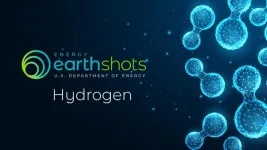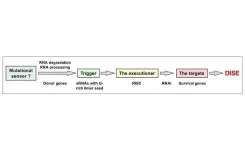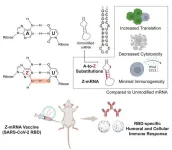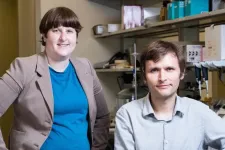(Press-News.org) To discover new treatments for genetic disorders, scientists need a thorough knowledge of prior literature to determine the best gene/protein targets and the most promising drugs to test. However, biomedical literature is growing at an explosive rate and often contains conflicting information, making it increasingly time-consuming for researchers to conduct a complete and thorough review.
To address this challenge, Cole Deisseroth, a graduate student enrolled in the M.D./Ph.D. program and mentored by Drs. Huda Zoghbi and Zhandong Liu at the Jan and Duncan Neurological Research Institute (Duncan NRI) at Texas Children’s Hospital and Baylor College of Medicine, led a study to generate a natural language processing (NLP) tool called PARsing ModifiErS via Article aNnotations (PARMESAN). This new tool can search for up-to-date information, assemble it into a central knowledge base, and even predict likely drugs that could correct specific protein imbalances. A description of the tool and its capabilities was published recently in the American Journal of Human Genetics.
“PARMESAN offers a wonderful opportunity for scientists to speed up the pace of their research and thus, accelerate drug discovery and development,” Howard Hughes Medical Institute investigator, Dr. Huda Zoghbi, who is also the founding director of Duncan NRI and distinguished service professor at Baylor College, added.
This artificial intelligence (AI)-powered tool scans through public biomedical literature databases (PubMed and PubMed Central), to identify and rank descriptions of gene-gene and drug-gene regulatory relationships. However, what stands out about PARMESAN in particular is its ability to leverage curated information to predict undiscovered relationships.
“The unique feature of PARMESAN is that it not only identifies existing gene-gene or drug-gene interactions based on the available literature but also predicts putative novel drug-gene relationships by assigning an evidence-based score to each prediction,” Dr. Zhandong Liu, Chief of Computation Sciences at Texas Children’s Hospital and associate professor at Baylor College of Medicine, noted.
PARMESAN’s AI algorithms analyze studies that describe the contributions of various players involved in a multistep genetic pathway. Then it assigns a weighted numerical score to each reported interaction. Interactions that are consistently and frequently reported in the literature receive higher scores, whereas interactions that are either weakly supported or appear to be contradicted between different studies are assigned lower scores.
PARMESAN currently provides predictions for more than 18,000 target genes, and benchmarking studies have suggested that the highest-scoring predictions are over 95% accurate.
"By pinpointing the most promising gene and drug interactions, this tool will allow researchers to identify the most promising drugs at a faster rate and with greater accuracy," Cole Deisseroth, said.
-------------------------------------------------------------
Others involved in the study were Won-Seok Lee, Jiyoen Kim, Hyun-Hwan Jeong, Ryan S. Dhindsa, and Julia Wang. They were affiliated with one or more of the following institutions: Baylor College of Medicine, the Jan and Dan Duncan Neurological Research Institute at Texas Children’s Hospital, the University of Pennsylvania, and Howard Hughes Medical Institute. The study was supported by the National Institutes of Health (NIH), the Medical Scientist Training Program of Baylor College of Medicine, the Robert and Janice McNair Foundation M.D./Ph.D. Student Scholar Program, Howard Hughes Medical Institute International Student Research Fellowship, the BrightFocus Foundation, the JPB Foundation, the CHDI Foundation, the Huffington Foundation, and the Ting Tsung and Wei Fong Chao Foundation.
END
PARMESAN: An AI-based predictive tool to find new treatments for genetic disorders
2023-10-03
ELSE PRESS RELEASES FROM THIS DATE:
PPPL awarded $5 million to lead an Energy Earthshot Research Center focused on clean hydrogen
2023-10-03
Lessening the effects of climate change will require a variety of innovations and a lot of ingenuity. Now, a new center led by the U.S. Department of Energy’s (DOE) Princeton Plasma Physics Laboratory (PPPL) will help these efforts by advancing the understanding of plasma-based clean hydrogen production.
PPPL was selected to lead a DOE Energy Earthshot Research Center (EERC) as part of the Hydrogen Shot™, which aims to reduce the cost of hydrogen by 80%. With funding from the DOE’s Office of Science, the EERCs support fundamental ...
Illinois-led project to sequence 400 soybean genomes, improve future crops
2023-10-03
As a source of protein and biodiesel for cleaner renewable energy, soybean is an important crop worldwide. But is it performing to its full potential? An ambitious effort led by the University of Illinois Urbana-Champaign and the U.S. Department of Energy Joint Genome Institute (JGI) will sequence 400 soybean genomes to develop a “pangenome” — an attempt to characterize all the useful diversity in the genome to create an even more robust and resilient crop.
The soybean pangenome project will sequence and analyze at least 50 soybean genomes from cultivated lines and wild relatives at reference quality, the gold standard of modern sequencing. A further ...
An ancient anti-cancer mechanism: DISE
2023-10-03
“DISE is effective against all cancers we tested.”
A new editorial paper was published in Oncotarget's Volume 14 on September 25, 2023, entitled, “DISE, an ancient anti-cancer mechanism that senses mutational load in cancerous cells?”
In their new editorial, researchers Monal Patel and Marcus E. Peter from Northwestern University discuss a recent breakthrough in cancer therapy. Despite the multiple advances in therapy, cancer remains one of the most common causes of death globally. ...
Project aims to develop all-in-one semiconductor that stores, processes data
2023-10-03
A multi-institutional project led by a Penn State researcher is focused on developing an all-in-one semiconductor device that can both store data and perform computations. The project recently received $2 million in funding over three years as part of the new National Science Foundation Future of Semiconductors (FuSe) program, a $45.6 million investment to advance semiconductor technologies and manufacturing through 24 research and education projects across the United States.
“The goal of ...
Nemours Children’s Health hosts first-ever pediatric session at HLTH
2023-10-03
Nemours Children’s Health will host the first-ever dedicated pediatric session at HLTH, the leading platform bringing together the entire health ecosystem focused on health innovation and transformation. This invited program, “Elevating Kids Health Well Beyond Medicine,” will extend HLTH’s 2023 theme, “Elevating Humanity,” to focus on health in childhood and why it is the only way to build good health across the lifespan.
“The child health perspective is an essential viewpoint for the attendees of HLTH to consider and we are proud to offer ...
OU Engineering among top 28 teams nationwide selected for DEPSCoR Grant
2023-10-03
University of Oklahoma engineering researcher Reza Foudazi, Ph.D., has been selected to receive a $600,000 grant from the U.S. Department of Defense under the Defense Established Program to Stimulate Competitive Research, or DEPSCoR. The highly competitive grant was awarded to only 28 academic teams nationwide.
An associate professor in the School of Sustainable Chemical, Biological and Materials Engineering, Foudazi’s research centers on the exploration of electrochemical energy storage systems that incorporate multivalent ions. ...
From A to Z: An alternative base modification for mRNA therapeutics
2023-10-03
Messenger RNA (mRNA) technology has become popular in the last few years due to its use in COVID-19 vaccines. This technology has been so groundbreaking that it recently won the 2023 Nobel Prize in medicine “for discoveries concerning nucleoside base modifications that enabled the development of effective mRNA vaccines against COVID-19.” This isn’t new technology, however— modified mRNAs have been studied for decades and show significant potential for therapeutic applications. Compared to unmodified mRNAs, modified ...
Legendary UTA professor establishes endowed professorship in heat transfer
2023-10-03
Abdolhossein Haji-Sheikh, a retired professor in the Mechanical and Aerospace Engineering Department at The University of Texas at Arlington, has made a $500,000 gift to support his former department.
The gift creates an endowed professorship in heat transfer, one of Haji-Sheikh’s areas of expertise during his decades of teaching at UTA. The professorship will be awarded in 2026.
Haji-Sheikh began his career at what was then Arlington State College in 1966. He said he wants to give back to ...
Instant evolution: AI designs new robot from scratch in seconds
2023-10-03
Inventor of xenobots unveils new advance toward artificial life
New AI algorithm compresses billions of years of evolution into seconds
The evolved robot has three legs and rear fins, something a human engineer would never devise
Researcher: ‘Now anyone can watch evolution in action as AI generates better and better robot bodies in real time.’
A team led by Northwestern University researchers has developed the first artificial intelligence (AI) to date that can intelligently design robots from ...
Two Rice bioengineers win NIH Director’s New Innovator awards
2023-10-03
Two Rice University bioengineers received the National Institutes of Health (NIH) Director’s New Innovator Award (NIA) for creative research projects demonstrating broad impact potential.
Part of the High-Risk, High-Reward Research program, NIA awards support early-career investigators with ambitious, unconventional project proposals “in any area of biomedical, behavioral or social science research relevant to the NIH mission,” according to the agency’s website.
Rice’s ...







